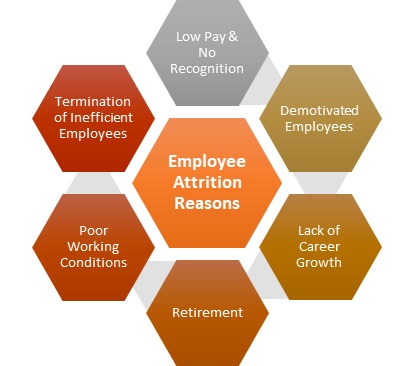- Business Concepts ›
- Human Resources (HR) ›
- Attrition
Attrition
Definition, Importance, Types, Steps, Factors & Example
This article covers meaning & overview of Attrition from HRM perspective.
What is meant by Attrition?
Attrition refers to the normal phenomenon of the employees leaving the company/organization voluntarily (or involuntary) due to reasons which can be professional or personal pertaining to the company's environment and culture. Attrition in a company is usually measured with a metric called attrition rate, which simply measures the no of employees moving out of the company (voluntary resigning or laid off by the company). Attrition Rate is also referred as churn rate or turnover. Though turnover tends to be more short term as compared to attrition. Internal job role movement may or may not be part of overall attrition but can be part of a particular unit's attrition.
Attrition Rate Formula & Example
Attrition rate refers to the rate at which employees are leaving an organization. This rate can be calculated as:
Attrition Rate (%)= (Number of separations/ Average Number of employees) * 100
The average number of employees considers both the employees who have left and who have been hired in that particular time frame. It gives an idea as to how many employees are leaving the company at any given time period. It is an important factor as companies have to prepare to start recruiting for the positions which are critical and cannot be left vacant.
For Example, If a report says that the attrition rate of a particular company was 10% this quarter this would mean that if company has 1000 employees, 100 have left the company in that particular quarter.
.Importance of Attrition
High attrition is a cause of concern for a company as it presents a cost to the company. The company loses on the amount it spent to recruit and select these employees and to train them for their respective jobs. The company may also have to spend additional money to fill the vacancies left open by these employees. Hence it becomes critical for a company to keep a tab on the attrition rate which down-sizes the employee base.
3 Types of Attrition
Broadly, there are 3 types of attrition which occur in any company.
1. Voluntary Attrition
When an employee leaves the company for a better job opportunity or career growth or more pay, and leaves on his own.
This can be due to multiple reasons like just the better role which is available externally or may be due to internal conditions.
2. Involuntary Attrition
If an employee is terminated from a job due to some issue like lack of performance. Sometimes, a degrowing business also forces employees to quit the job, which leads to a higher rate of people leaving.
Many times companies go for layoffs for business and financial reasons leading to involuntary attrition.
3. Retirement Attrition
Once an employee finishes his/her tenure at a company and retires. This is mostly a natural attrition that occurs and companies are prepared with succession planning.
Factors leading to Employee Attrition
There are several reasons why employees consider the option of moving out of the current organization. Some of the main reasons why attrition amongst employees exist are as follows:
1. Better pay & job opportunities outside the organization.
2. Low Pay or no recognition of employees
3. Improper work life balance can cause a high attrition rate.
4. Impolite behavior of managers and peers leading to ineffective team management and demotivation.
5. Stagnancy in career growth & poor quality of work life can lead to higher attrition rate.
6. Inadequate and poor working conditions leading to lack of motivation.
7. Retirement or untimely death of employees when at job.

Steps to Control Attrition
Companies can take several corrective actions in order to ensure that employees stay in the company and can reduce the number of people leaving. Some of the employee retention strategies to control attrition are mentioned below:
1. Motivating employees through a growth plan.
2. Recognize employee accomplishments through rewards.
3. Expose employees to newer roles and promote training and development within the organization which helps them build their careers.
4. Taking constant feedback from employees can help positively engage unsatisfied staff
5. Continuously strategize organizational structure to remove irrelevant job positions to reduce misfit recruitment.
Hence, this concludes the definition of Attrition along with its overview.
This article has been researched & authored by the Business Concepts Team which comprises of MBA students, management professionals, and industry experts. It has been reviewed & published by the MBA Skool Team. The content on MBA Skool has been created for educational & academic purpose only.
Browse the definition and meaning of more similar terms. The Management Dictionary covers over 1800 business concepts from 5 categories.
Continue Reading:
What is MBA Skool?About Us
MBA Skool is a Knowledge Resource for Management Students, Aspirants & Professionals.
Business Courses
Quizzes & Skills
Quizzes test your expertise in business and Skill tests evaluate your management traits
Related Content
All Business Sections
Write for Us